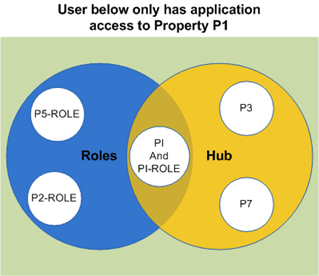19 About Roles
Prerequisites for Managing Roles
User roles are a classification assigned to users on the basis of their job title or responsibilities; granting access to features, data and actions through the assignment of tasks to these roles.
-
Chain Roles: Enable the same privileges across all properties in the chain (tenancy).
-
Property Roles: Typically created from a template role, property roles assign privileges for a single property. When the Property Role without Template OPERA Control is active, a stand-alone property role can be created, which is not based on a template role. When the Activate Template Tasks on all Dependent Property Roles OPERA Control is active, newly selected or deselected template tasks are applied to all dependent property roles.
Note:
Role assignment alone does not grant users access to properties; users must also be assigned to one or more hubs.Note:
A process runs regularly to ensure task changes to existing and new roles are updated. This process can take up to 10 minutes to take effect.Seeded Roles
Additionally, the following roles are seeded on provisioning of your chain and property.
| Role | Access to | Visible in Role Manager |
|---|---|---|
|
ADMIN |
OPERA Cloud to perform initial administration tasks to setup your chain and properties. See About Org-Admin Roles (ICCP Article). |
Yes, View only |
|
DATAACCESS |
OPERA Cloud for Oracle employee |
Yes, View only |
|
SENSITIVEDATAACCESS |
OPERA Cloud for Oracle employee |
Yes, View only |
|
GUESTEXPERIENCE |
Guest Experience Portal |
No |
|
DEVELOPERPORTALACCESS |
Accessing the Oracle Hospitality Integration Platform Developer Portal |
No |
|
CCCONF |
Payment Portal (OPI)- for Credit cards payments confirmation |
No |
|
CCTRANS |
Payment Portal (OPI) - Credit cards transactions |
No |
|
PPCONF |
Payment Portal (OPI) - Pre-paid payments confirmations |
No |
|
WSACCESS |
OHIP web-service access |
No |
Examples of Roles Configuration
Property Role Examples
An example of a user with one property role would be a Front Desk user working at a single property.
An example of a user with multiple property roles would be a Reservation Manager requiring elevated access for a specific property, and also requiring view access at other properties.
Chain Role Examples
An example of a user with a chain role would be a Regional General Manager or Regional Sales Manager, responsible for multiple hotels and requiring the same privileges across all properties.Chain and Property Role Example
An example of a user with a combination of chain and property roles would be a Revenue Manager requiring access to multiple properties within a chain, but only elevated access to select properties. Limited access to some or all properties in the chain is provided through a chain role and either the default hub or a new hub with a subset of properties. Elevated access to select properties is provided through property roles.
Users with chain roles assigned will also require the assignment of a property role when the Transaction Code by User Role OPERA Control is active. See Associating Transaction (Charge) Codes to Property Roles.
The following figure illustrates the configuration of a user’s assigned property roles and assigned hub. In this figure, P1 (Property 1) and P1-Role (Property 1 Role) are the only intersecting access credentials when looking at the roles and properties attached to this user's assigned hub. As a result, a user with this configuration can only access the P1 Property.
Figure 19-1 Assigned Property Roles and Hub
